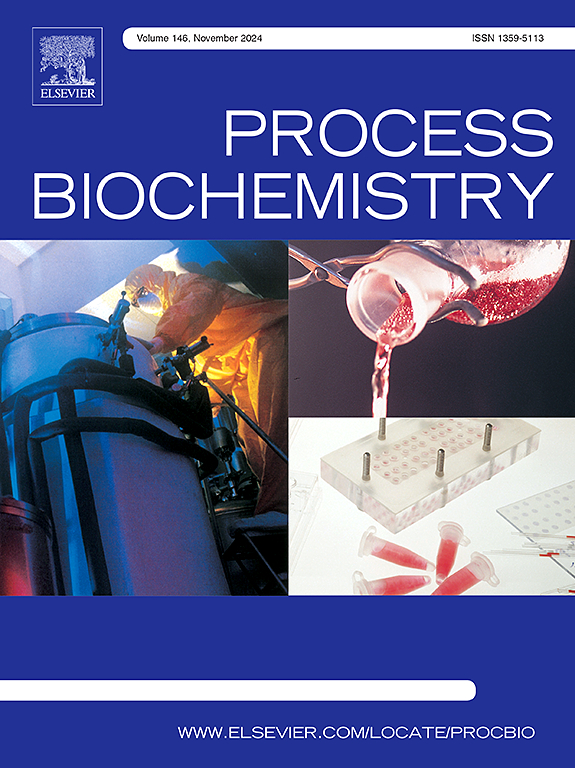搅拌流化床吸附生产和直接回收EGFP的综合优化:培养和搅拌条件的影响
IF 4
3区 生物学
Q2 BIOCHEMISTRY & MOLECULAR BIOLOGY
引用次数: 0
摘要
建立了一种优化大肠杆菌BL21中增强型绿色荧光蛋白(EGFP)上游生产和下游纯化的综合方法。采用实验统计设计对培养基成分进行优化,包括筛选关键变量的两水平分数析因设计(FFD)和采用响应面法(RSM)优化关键成分的中心复合设计(CCD)。葡萄糖(4.215 g/L)和硫酸铁(0.297 mg/L)的最佳浓度与改良的M9培养基相比,EGFP产量增加了333.1 %。为了纯化,在搅拌流化床吸附(SFBA)系统中进行streamlined DEAE离子交换色谱,该系统设计用于处理未澄清的大肠杆菌裂解物(50 %,w/v)。在0-200 rpm范围内优化搅拌速度,100-150 rpm提供最高的吸附效率、回收率(~ 87 %)和蛋白质纯度(纯化系数~ 2.7)。与传统的填充床系统不同,SFBA工艺可以直接从原油裂解物中捕获,提高了产量,缩短了处理时间,并增强了可扩展性。本研究证明了在SFBA中耦合培养优化与流体动力学调节对高产、无澄清回收EGFP的有效性,为工业生物加工中重组蛋白的生产和纯化提供了实用平台。本文章由计算机程序翻译,如有差异,请以英文原文为准。
Integrated optimization of EGFP production and direct recovery using stirred fluidized bed adsorption: Effects of culture and stirring conditions
An integrated approach was developed to optimize upstream production and downstream purification of enhanced green fluorescent protein (EGFP) in Escherichia coli BL21. Culture medium components were optimized using a statistical design of experiments, including a two-level Fractional Factorial Design (FFD) to screen key variables and a Central Composite Design (CCD) with Response Surface Methodology (RSM) to refine critical components. The optimal concentrations of glucose (4.215 g/L) and FeSO₄ (0.297 mg/L) resulted in a 333.1 % increase in EGFP production compared to a modified M9 medium. For purification, STREAMLINE DEAE ion-exchange chromatography was implemented in a stirred fluidized bed adsorption (SFBA) system designed to handle unclarified E. coli lysates (50 %, w/v). Stirring speed was optimized across the 0–200 rpm range, with 100–150 rpm providing the highest adsorption efficiency, recovery yield (∼87 %), and protein purity (purification factor ∼2.7). Unlike traditional packed-bed systems, the SFBA process enabled direct capture from crude lysates, improving throughput, reducing processing time, and enhancing scalability. This study demonstrates the effectiveness of coupling culture optimization with hydrodynamic tuning in SFBA for high-yield, clarification-free recovery of EGFP, offering a practical platform for producing and purifying recombinant proteins in industrial bioprocessing.
求助全文
通过发布文献求助,成功后即可免费获取论文全文。
去求助
来源期刊

Process Biochemistry
生物-工程:化工
CiteScore
8.30
自引率
4.50%
发文量
374
审稿时长
53 days
期刊介绍:
Process Biochemistry is an application-orientated research journal devoted to reporting advances with originality and novelty, in the science and technology of the processes involving bioactive molecules and living organisms. These processes concern the production of useful metabolites or materials, or the removal of toxic compounds using tools and methods of current biology and engineering. Its main areas of interest include novel bioprocesses and enabling technologies (such as nanobiotechnology, tissue engineering, directed evolution, metabolic engineering, systems biology, and synthetic biology) applicable in food (nutraceutical), healthcare (medical, pharmaceutical, cosmetic), energy (biofuels), environmental, and biorefinery industries and their underlying biological and engineering principles.
 求助内容:
求助内容: 应助结果提醒方式:
应助结果提醒方式:


